“], “filter”: { “nextExceptions”: “img, blockquote, div”, “nextContainsExceptions”: “img, blockquote, a.btn, a.o-button”} }”>
In yoga, we often overemphasize the stretching aspect of poses, especially when it comes to hip openers. We can feel the inner thigh stretch when we hold stances in which the legs are apart, such as Warrior II and Low Lunge. But bringing your legs back in toward the center of your body presents a different challenge—and that’s where contracting and strengthening the muscles of your inner thighs come into play.
The anatomy of the inner thighs
“Adduction” refers to bringing parts of your body (in this case, your legs) toward your body’s midline. Think of adduction as “adding” a body part to your center. Your adductors consist of 5 muscles:
- Adductor magnus
- Adductor longus
- Adductor brevis
- Gracilis
- Pectineus
When you’re in a standing or seated posture with your legs wide and then bring them back to your center, you’re contracting your adductors. It’s this contraction that provides the squeezing force necessary. These muscles work in tandem with one another to also rotate your thighs internally and externally, flex and extend your thighs, and provide general stability in your lower body, especially in standing or wide-legged poses.
Conversely, taking your legs apart, as in Wide-Legged Forward Fold, requires stretching the muscles in your inner thighs and hips. Both inner thigh stretches and strengthening exercises are needed for balance. Strengthening your inner thighs keeps your lower body stable and supported. Stretching your adductors allows for comfortable hip opening and overall mobility in your lower body, providing the added bonus of reducing your chances of experiencing “groin strain” or other hip injuries that can occur from side-stepping unexpectedly and forcefully in daily life.
By focusing on both stretching and strengthening your inner thighs, your hips and groin will also benefit, bringing improved flexibility and stability to your practice and your everyday life, whether you’re walking, running, or skiing down a mountain.
6 inner thigh stretches and strengthening poses
Upavistha Konasana (Wide-Angle Seated Forward Bend)

This posture deeply stretches the groin and upper inner thighs, and provides a good gauge for hip flexibility in general. Proper form is more important than being able to get your chest close to the floor, so focus on keeping your legs rotated out and maintaining a flat back, even if you only lean forward an inch.
How to: Begin in Dandasana with your legs out in front of you, sitting on your glutes. When you’re ready, spread your legs apart as far as feels comfortable while being able to keep both legs straight and feet flexed upward. On an inhalation, lift through your spine and the crown of your head, then exhale on the release as you walk your hands out in front of you, shoulder-width apart. Fold at your hip joint and maintain a flat back as your bring your torso toward the floor. Hold for 5 breaths. To exit, walk your hands back to your body as you slowly raise your torso back above your hips.
Janu Sirsasana (Head-to-Knee Pose)
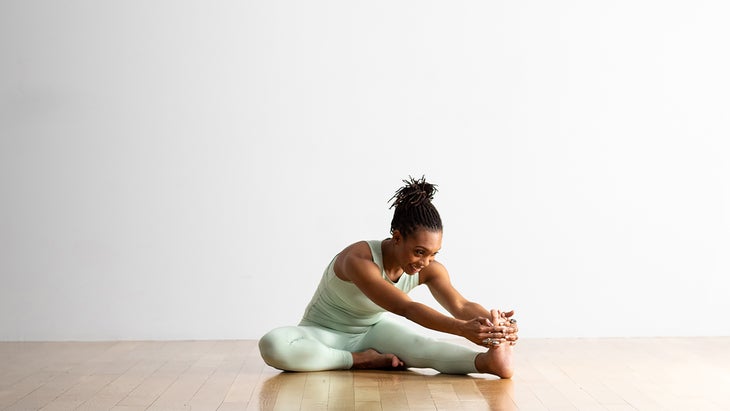
While you’ll feel this seated stretch primarily in your hamstrings, your adductors will also experience a stretch. When in the posture, you may feel your body’s tendency to turn the thigh and foot of your straight leg in toward your body. To counteract this, actively turn your extended leg and foot away from your body slightly so your knee points toward the ceiling. This stretch for the inner thighs is slightly more accessible than having both legs extended wide at the same time.
How to: Begin in Dandasana and bend your right knee, bringing your right foot to your left hip crease. On an inhalation, lift through your spine and the crown of your head, then on an exhalation, bring your right hand to your left thigh and your left hand behind your left hip. The aim is to turn your torso in line with your extended left leg. Inhale and lengthen here, then on an exhalation, bend at your hip joint and reach both hands out toward your left foot. (If it helps, you can loop a yoga strap around the arch of your foot.) Maintain a flat back with your left toes flexed upwards. Focus on your left thigh here, being careful to make sure it’s rotated away from your body’s centerline so your left foot does not droop in toward your hips. Hold for 5 breaths. To exit, draw your hands back to your waist as you raise your torso above your hips.
Baddha Konasana (Bound Angle Pose)
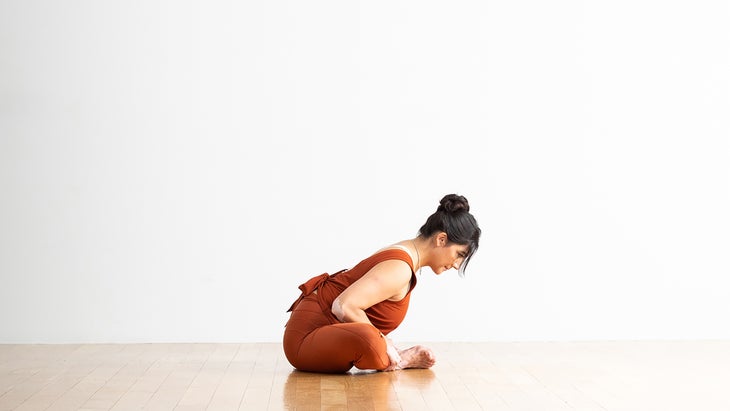
Bound Angle or Cobbler’s Pose offers a comfortable seat that let’s you adjust the intensity. The closer your feet are to your hips, the more difficult the pose becomes. However, it can be modified by placing your feet farther away from your hips and leaning forward, enabling you to still feel a stretch in your inner thighs without needing to start with a large amount of flexibility.
How to: Begin in Dandasana and bend your knees, allowing them to fall outwardly. Next, draw your feet together, forming a diamond shape from your groin out to your knees and meeting at your feet. If it’s accessible, wrap your hands around your feet or ankles and lightly pull to straighten your back, forming a line from the base of your spine to the crown of your head. While maintaining this back posture, begin to lean forward from your hip joint. Remain as long as feels comfortable. To exit, release your hands and return your legs to Dandasana.
Setu Bandha Sarvangasana (Bridge Pose) with a Block
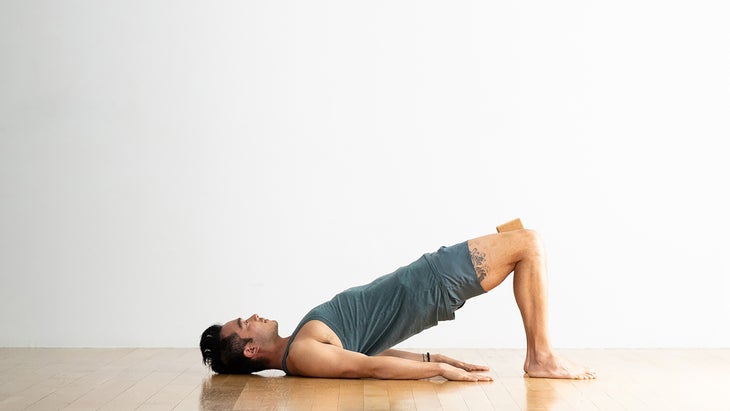
Strengthen your adductors by squeezing your thighs together in this pose. You can engage the adductors even without a block, but having something to press your legs into allows you to maintain that focus. It also enables you to gauge how hard each leg is pushing; you’ll notice the block shift slightly if one leg is overpowering the other.
How to: Begin by lying on your back with your knees bent and feet parallel, hip-width apart. Keep a block by your side. Next, move your feet toward your glutes as you reach both arms toward your heels. Then, on an inhalation, lift your hips toward the ceiling. Place your block in between both legs and press your thighs together to keep the block elevated. Option to hold this position for 5 breaths, or to do a circuit of squeezing for one breath, then removing the block and lowering your hips to the ground for 5 repetitions. To exit, lower your hips to the floor and walk your feet out into Savasana.
Utthita Trikonasana (Extended Triangle Pose)
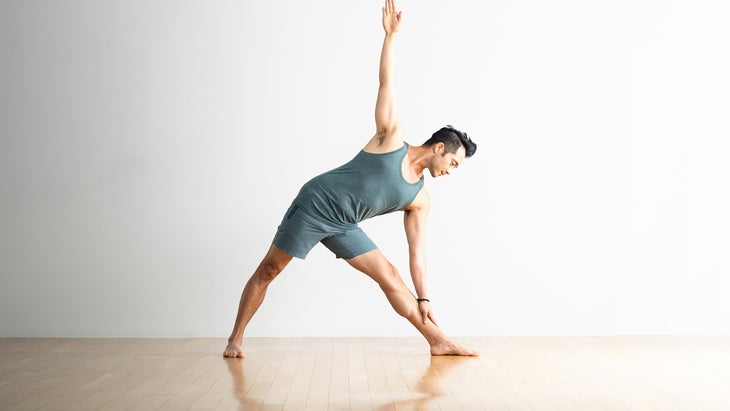
Triangle Pose calls upon your adductors to keep your front leg stable and rotated slightly outward. The posture also stretches the adductors of both legs.
How to: Begin in Mountain Pose. Step your feet 3 to 4 feet apart, or slightly farther than both shoulders. Raise your arms parallel to the floor and turn your right foot out 90 degrees. Follow this by turning your left foot in toward your body slightly. Keep both heels in alignment. Rotate your right thigh outward. On an exhalation, extend your torso to the right then fold down at your hip joint, bringing your right arm to the inside of your right knee, left arm remaining straight back and in line with your right arm. Draw your left hip back and ground your left foot into the floor. Hold for 5 breaths. On an inhalation, slowly bring your torso back above your hips, lower your arms, and pivot both feet back to parallel. Repeat on the other side.
Garudasana (Eagle Pose)
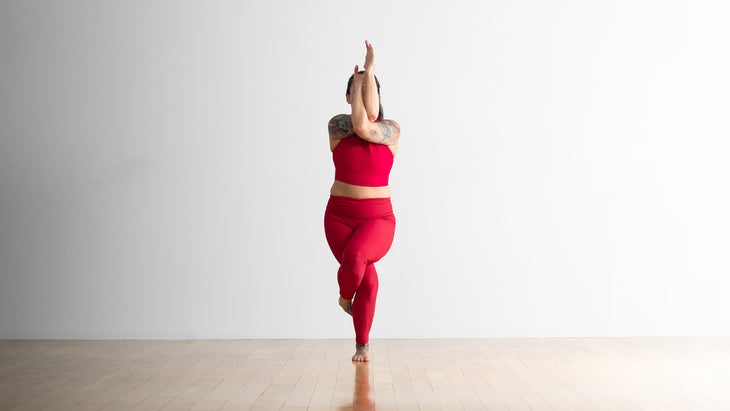
This pose requires strength and flexibility, calling on the contraction of your groin muscles to keep you stable as you squeeze your legs together. Your hips and lifted leg will want to slant in the direction of your lifted knee; to counteract this, engage the adductor muscles of your standing leg to draw your pelvis back to facing forward.
How to: Begin in Tadasana with your feet slightly apart. When you’re ready, bend both knees and lift your left leg up and over your right thigh, wrapping your left foot around your right calf. Then, reach both arms out in front of you and place your right elbow in the crook of your left elbow. Bend both arms 90 degrees at the elbow, bring your thumbs toward your face, and place your palms together. Hold for 5 breaths. To exit, release your arms first then unwind your left leg, placing your left foot back down by your right foot. Repeat on the other side.

